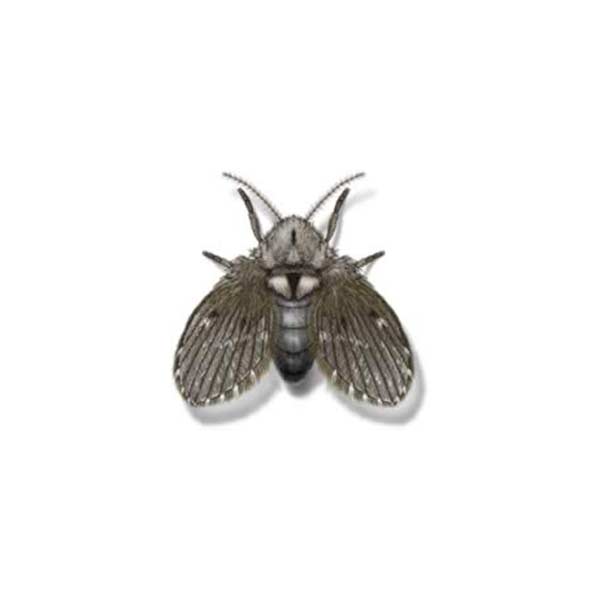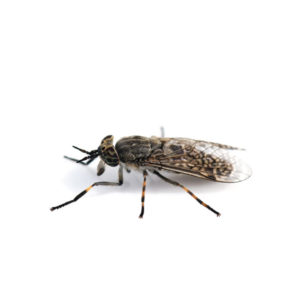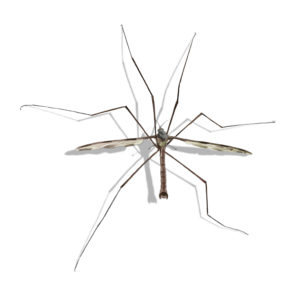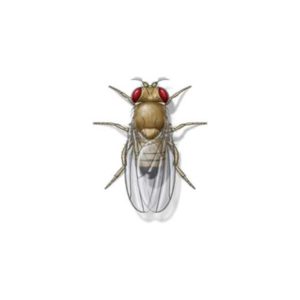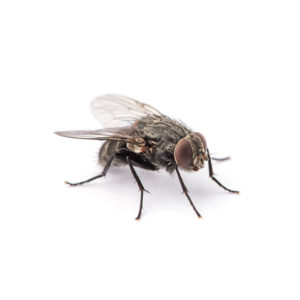Drain flies, also called moth flies, belong to the family Psychodidae and get their name because they often breed in drains. They are found throughout the United States and can become an annoyance in homes, sometimes appearing suddenly from sinks and bathtub drains. They can breed in tremendous numbers in sewage treatment plants and then be carried away by the wind to nearby buildings, where they can crawl through fly screens. Their presence can indicate deeper sanitation issues that, if not addressed, may lead to larger infestations.
Unsure on the type of fly you are dealing with? Take a look at the most common flies found in North Carolina to help identify the specific fly species.
Drain Fly Identification
What Do Drain Flies Look Like?
Drain flies, also known as moth flies due to their moth-like appearance, are small insects about 1/8 inch in length. They possess a unique set of fuzzy, moth-like wings, which when at rest, are held over their body in a roof-like manner. Their bodies are typically dark, ranging from gray to tan, and they have long antennae that contribute to their distinctive silhouette.
Signs of a Drain Fly Infestation
Recognizing the signs of a drain fly infestation is key to early intervention. Common indicators include:
- Persistent sightings of small, moth-like flies around drains, sinks, and showers.
- The presence of larvae and pupae in the slime layer of drains, often requiring a flashlight and a small probe to detect.
An increase in adult fly activity in the evening, attracted to light sources within the home.
Habitat, Diet, Life Cycle & Bites
Where Do Drain Flies Live?
Drain flies develop in muck or gelatinous material that accumulates in sewage disposal beds, septic tanks, moist compost, or dirty garbage containers. They may also emerge from drains of sinks or bathtubs, from tree holes, rain barrels, moist organic solids, or bird nests that have accumulations of fecal material. Drain flies gather, mate, and lay eggs in moisture or standing water. The slimy film that forms in sewers and drains is a favorite breeding spot. Inside structures, they are strongly attracted to light and will be found on glass windows, doors, lamps, and indoor lighting.They can also be found in outdoor areas with stagnant water, such as clogged rain gutters and birdbaths.
Populations of these insects can become a nuisance in homes, and their presence is almost always linked to a clogged drain. In residential homes, the most common breeding sites are bathroom drains. Drain flies are weak fliers and when encountered, they are often found crawling on walls and other surfaces.
Diet of a Drain Fly
The larvae of drain flies feed on the organic matter found within slimy films that accumulate in drains and pipes. This material includes decaying vegetation, fungi, algae, and bacteria. Adult drain flies, in contrast, have a very short lifespan during which they seldom eat, if at all.
Life Cycle of a Drain Fly
The life cycle of drain flies encompasses four stages: egg, larva, pupa, and adult. Females lay eggs in the organic material found in moist environments. Larvae emerge within 48 hours, feeding on the surrounding organic matter. After approximately 9 to 15 days, larvae enter the pupal stage, emerging as adults after about 20 to 40 hours. The entire life cycle can be completed in as little as one week under optimal conditions, leading to rapid population growth.
Drain Fly Bites
Drain flies do not bite people or animals or do damage to structures or plants. However, because these flies originate from filthy sources, they have the potential of being mechanical vectors of diseases.
Are Drain Flies Dangerous?
While drain flies do not pose a direct health risk to humans or pets, their presence can indicate a lack of sanitation in affected areas. Large infestations can exacerbate respiratory conditions in sensitive individuals due to the potential inhalation of debris and bacteria associated with their breeding sites.
How to Get Rid of Drain Flies?
Eradicating drain flies involves a multifaceted approach targeting both the adult flies and their larvae.
- Thorough Cleaning: Regularly cleaning and disinfecting drains is essential. Mechanical cleaning with a brush can physically remove the biofilm that larvae feed on, while boiling water or a mixture of baking soda and vinegar can help dissolve organic material.
- Enzymatic Drain Cleaners: Using enzymatic cleaners can break down organic matter without the harshness of chemical drain cleaners, making it a more environmentally friendly option.
- Professional pest control: For persistent infestations contact our professional fly control experts to help eliminate any larvae and eggs residing in drains.
Drain Fly Prevention Tips
Preventing drain fly infestations is preferable to dealing with an active infestation. Key prevention strategies include:
- Regular Maintenance: Regularly inspect and maintain drains to prevent the accumulation of organic material. Use enzymatic cleaners monthly to keep drains clear of the slime that attracts drain flies.
- Reduce Moisture: Fix leaky faucets and pipes to reduce excess moisture and standing water in and around your home. Ensure good ventilation in moist areas to discourage drain fly habitation.
- Seal Entry Points: Seal cracks and crevices around doors, windows, and plumbing to prevent adult drain flies from entering your home from the outside.
Need help with Drain Flies control?
FAQs
Why Do I Suddenly Have Drain Flies in My House?
A sudden appearance of drain flies typically indicates an increase in the organic material within your drains, providing ideal breeding conditions for these pests. Leaky pipes and infrequently used drains can also contribute to their presence.
Will Drain Flies Go Away on Their Own?
Without intervention, drain flies are unlikely to go away on their own. Eliminating their breeding grounds and food sources is necessary to permanently reduce their numbers- that’s where we can help!
What Attracts and Kills Drain Flies?
Drain flies are attracted to moist environments with organic buildup. Cleaning agents that break down this organic material, physical removal of slime and grime, and professional pesticides can all effectively kill drain flies.

